10 jobs 10 outstanding minds of mankind
If a cluttered table means a mess in the head, then what does an empty table mean?
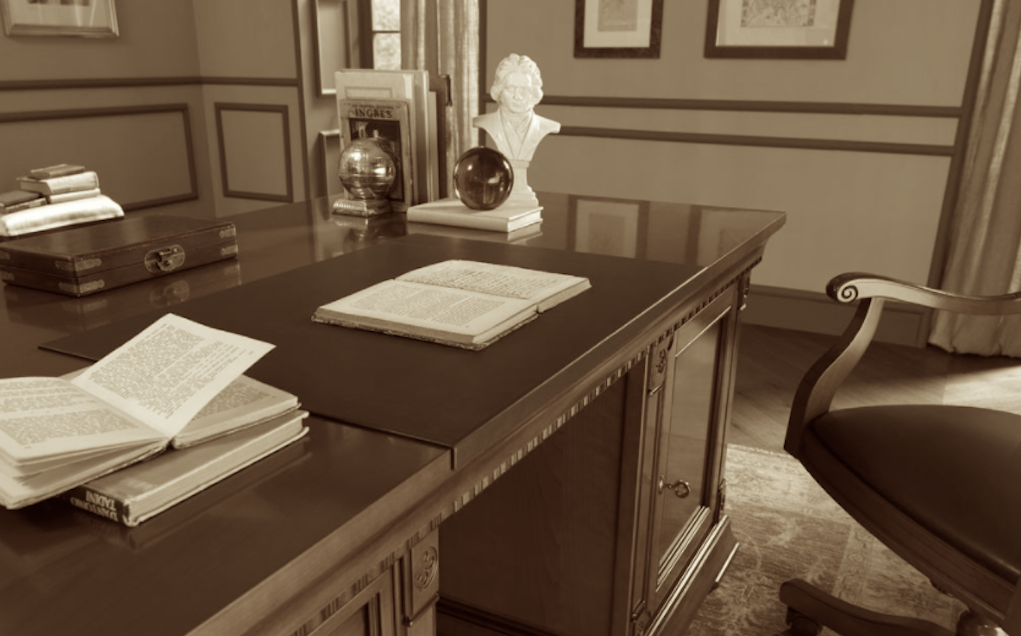
These words belong to Albert Einstein. Most likely this saying was said to justify its lack of organization, rather than summing up any mass observation of the human psyche. The truth is that the fact how the workspace is organized can tell a lot about its owner. According to old studies, people who receive a high salary cannot boast of an ideal purity of their workplace. In 2013, scientists from the University of Minnesota conducted a similar study: as a rule, the cluttered workplaces belonged to risky and creative individuals, but individuals who in life followed schedules and rules clearly organized their working space.
“Random jobs, it seems, inspire, give impetus to the emergence of new ideas,” the researchers concluded.
Here is another story of a study conducted in the same 2013. College students were asked to come up with as many options for using Ping-Pong balls. At the same time, various working spaces were created for work - neat and erratic. Interestingly, students who worked in the "chaos office" could offer more creative options for the use of balls. Of course, all this is generalizations that require more detailed research, if the table is dirty - this is not a fact, it is not at all a fact that a genius is sitting behind it! The article for example contains the workspaces of the brilliant minds of world science. This is the environment in which they created, created and made discoveries.
1. Table by Albert Einstein on the day of his death in 1955
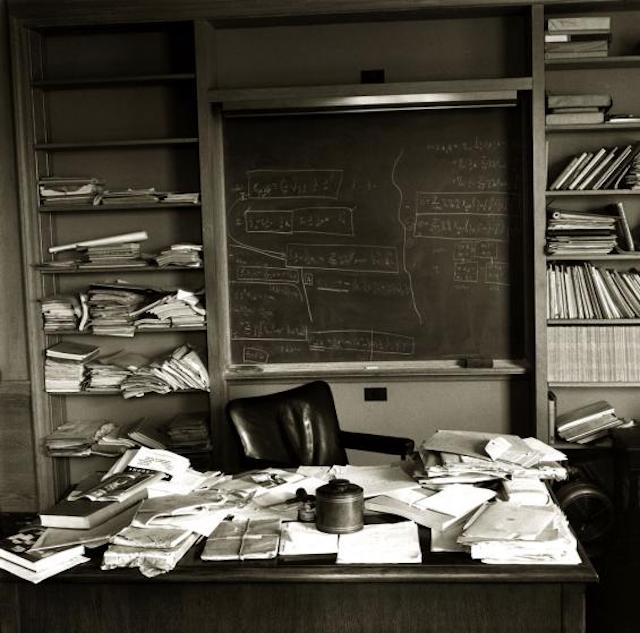
Photographed by Ralph Morse for LIFE magazine, this image of Einstein’s table, untouched and left just like the day he died, became iconic. Morse was tasked with documenting the events of the day when the greatest mind went away. Morse told how on the way to the Institute for Advanced Study, he went to the store for scotch tape.
“I knew that people are usually reluctant to talk, but many people gladly accept a bottle of drinks, not money, in exchange for help,” Morse said. "So, I got to the building, found the superintendent, gave him scotch and voila: the office is open."
2. Super charging "amplifying transmitter" Nikola Tesla. 1899
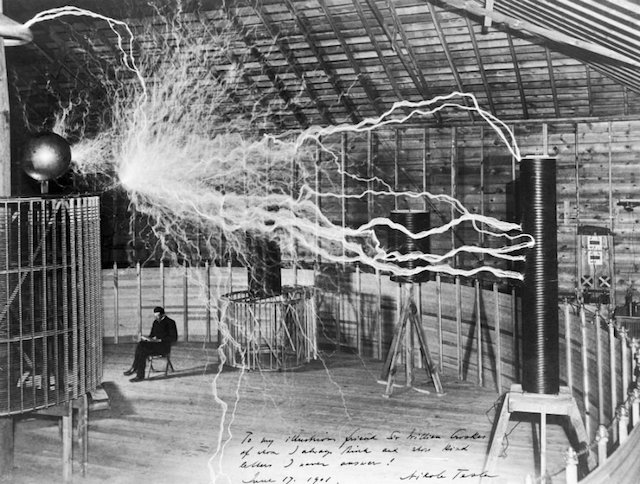
The famous image above was captured inside the Tesla laboratory in Colorado Springs in 1899, but the photo shows everything not without the use of the tricks of the photographer, the “photoshop” of that time. The photo was taken by Dickinson V. Alley for an advertising campaign; on the image, Tesla looks very relaxed next to a giant “amplifying transmitter” - a high-voltage generator. It is logical that Tesla knew better than anyone, what is fraught with such an energetically powerful neighborhood.
To create a photo, Dickinson V. Alley first captured the massive sparks of the car in a darkened room, and then put the photographic plate back in and photographed Tesla sitting in a chair with the car turned off. In his notes on Colorado Springs, Tesla admitted that the photo was “made to order”: “Of course, there was no discharge during my photography, it was done only for a spectacle and a game of imagination!”
3. Jane Goodall records her field notes in Gombe Stream National Park, Tanzania
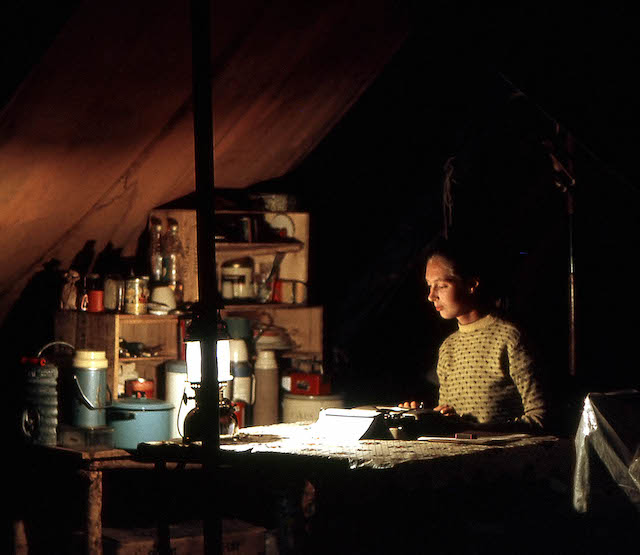
If you want to study primates, you will not do this with individuals trapped in a laboratory; the famous primatologist Jane Goodall knows this from experience. More than 50 years ago, Goodall, having left her position as an assistant anthropologist Luis Leakey, went to work in the wildlife of East Africa to study chimpanzees and what she observed in Tanzania in Gombe Stream National Park, revolutionized our understanding of primates.
But, as Alison Maloney writes for The New York Times, what might seem like a dream for every budding biologist wasn’t really that simple:
"The history and successful result of her work with chimpanzees in Gombe were so glorified that in these rays it is easy to forget how she, being a young girl with burning eyes, was forced to dwell in the forest in the old ex-army tent in which spiders and scorpions and snakes. She shared her work space with her mother Margaret. ”
4. NASA scientists with a calculation board, 1961
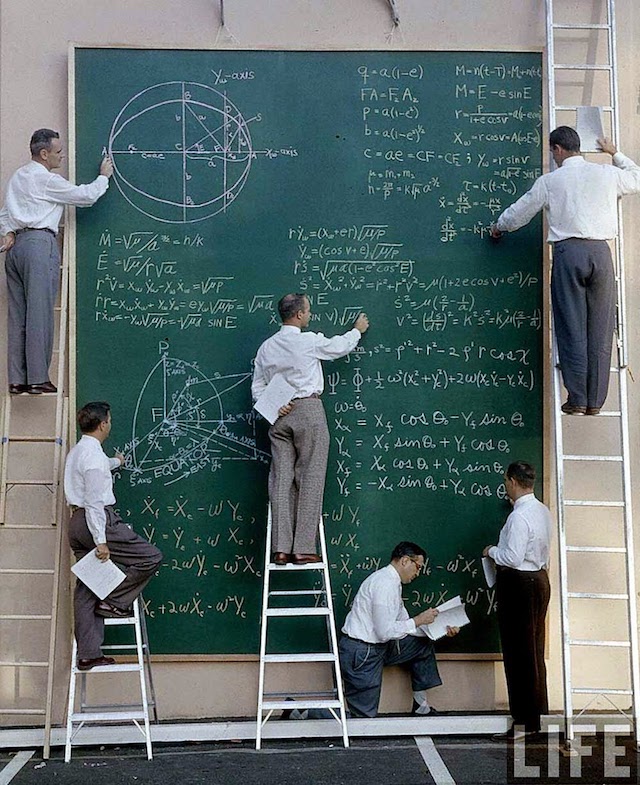
That is how they worked before computers appeared. The board, which was photographed for the LIFE magazine in 1961, was most likely created to look very scientific and impressive in the photo. The blog "Rare historical photographs" noted that there are no calculation equations on it.
"Let's be honest, this was the middle of the space race, and they would not publish anything but general equations in LIFE magazine." This photo is of course staged, but perhaps something like the work of scientists behind closed doors. To solve complex equations, NASA scientists each worked on their own “mathematical game”. The scientist owned one part of the equation.
5. Stephen Hawking table at the University of Cambridge, 2012
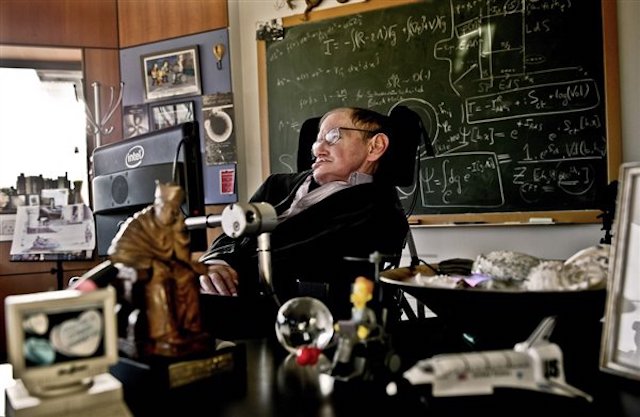
One of a series of photographs of portraits was commissioned by the London Science Museum to celebrate the 70th anniversary of Hawking, January 8, 2012. In this image, the British theoretical physicist Stephen Hawking at his working "non-empty" table. Many strange things from the whole Hawking office were staged on the table surface to get into view and demonstrate to the public what the greatest mind works on.
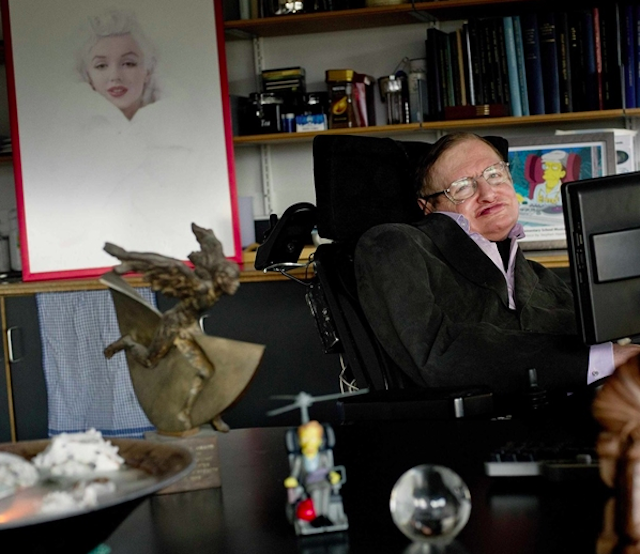
Among the objects that can be seen are the 2 kilogram bronze statue of the pope, Simpson the figure of Hawking, the model of the space shuttle and the crystal ball representing the world map. In the second photo from the same series, a portrait of Marilyn Monroe is hanging over Hawking.
6. Former NASA astronaut Mae Carol Jamison aboard the Endeavor spacecraft
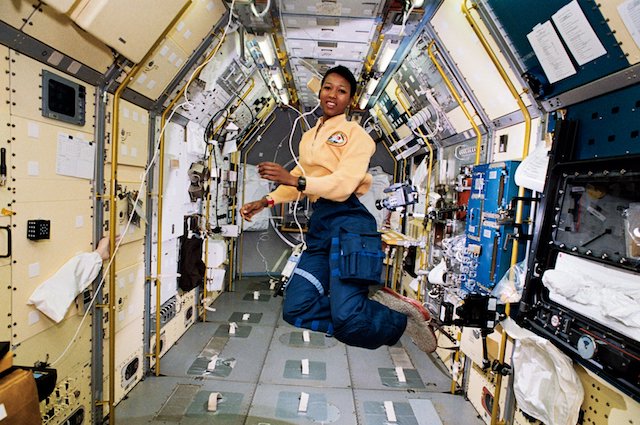
NASA American physician and astronaut Mae Jamison became the first African woman to travel into space after going into orbit aboard the Space Shuttle Endeavor in 1992. It was her only space flight, Jamison joined five other NASA astronauts, and for eight days the team conducted research as part of the mission Spacelab Japan. Now she is the president and founder of two technology companies. By the way, May even played an astronaut in the Star Trek series, although the role was episodic.
7. Buckminster Fuller and his desktop, which is littered with geodesic domes

American architect, theorist, inventor Buckminster Fuller, was perpetuated in the name of molecular compounds, which are a closed sphere consisting of sixty carbon atoms - fullerenes. Fuller's famous geodesic domes were built according to this principle.
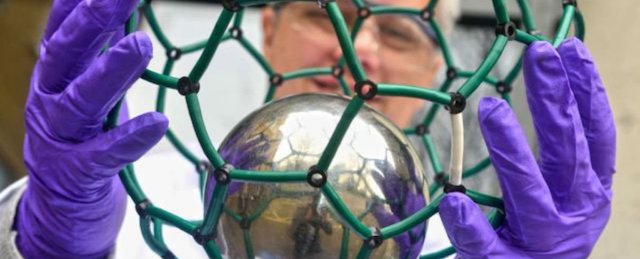
Although for the first time these structures were invented by a German engineer 30 years earlier than Fuller, it was the American scientist who received the patent of the United States. So why not surround them with your workspace?
8. Marie Curie in her laboratory, 1898
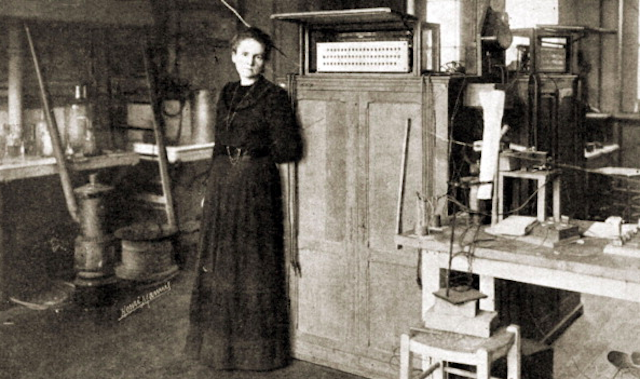
If you present a picture with the caption "no fuss", then it could be the incarnation of the photo, which depicts the French physicist Marie Curie, born in Poland, in her incredibly bright laboratory at the Sorbonne, Paris. It was 1898 and she had no idea what would be the first woman to win the Nobel Prize twice: the first and only woman, and indeed the only person who twice won the Nobel Prize.
“Silent, dignified and unassuming” is all about her, and the modest and peaceful work space in which she worked makes her incredible achievements even more significant.
9. NASA computer scientist Margaret Hamilton, photographed with the source code for the Apollo on-board computer, 1969
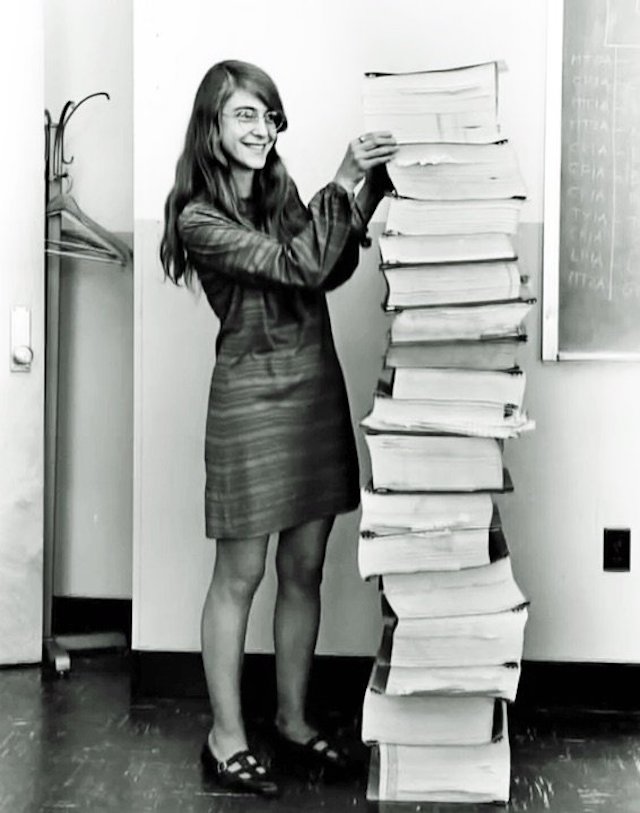
She is only 29 years old in the picture, Hamilton was responsible for the on-board software for the Apollo 11 computer. In 1969, it was this moment that was captured in the photo above — she and J. Halcombe Lan developed an operating system for the Apollo space program, which prevented possible failure of the moon landing.
Here is what Hamilton said in an interview for Datamation magazine, 1971:
The computer has been programmed to more than just recognize erroneous conditions. The software provided a complete set of recovery programs. In this particular case, the response of the software was to suspend the work of low-priority tasks and re-establish the most important ones. If the computer did not recognize this problem and did not take remedial measures, I am not sure that Apollo 11 would have made a successful landing on the moon.
10. Thomas Edison dictates instructions to the employee on the new type of dictaphone “Telescribe”, 1929
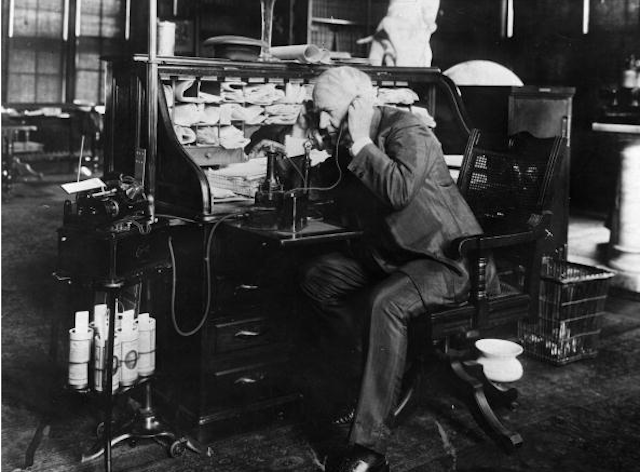
Thomas Edison considered the time spent on sleep to be empty because he practiced polyphasic sleep (alternation of wakefulness and short sleep). He slept no more than 3 hours a day, so seeing him asleep in the workplace in various parts of the laboratory was not unusual.
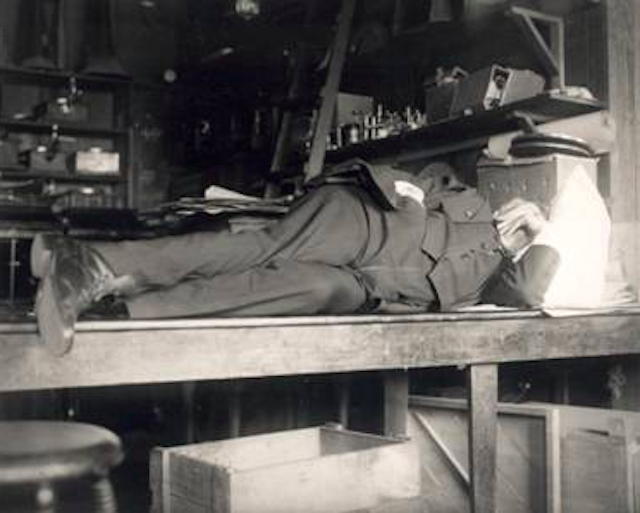
These different workspaces are characteristic of some scientists and outstanding personalities. It will be true, nevertheless, to be guided by your sense of comfort, creating an atmosphere in your workplace, if, of course, the leadership permits, and the “design” of placing things and tools on the table in Feng Shui does not break the office’s dress code.
As advertising. Stock! Only now get up to 4 months of free use of VPS (KVM) with dedicated drives in the Netherlands and the USA (configurations from VPS (KVM) - E5-2650v4 (6 Cores) / 10GB DDR4 / 240GB SSD or 4TB HDD / 1Gbps 10TB - $ 29 / month and above, options with RAID1 and RAID10 are available) , a full-fledged analogue of dedicated servers, when ordering for a period of 1-12 months, the conditions of the promotion are here, existing subscribers can receive a 2-month bonus!
How to build the infrastructure of the building. class c using servers Dell R730xd E5-2650 v4 worth 9000 euros for a penny?
All Articles